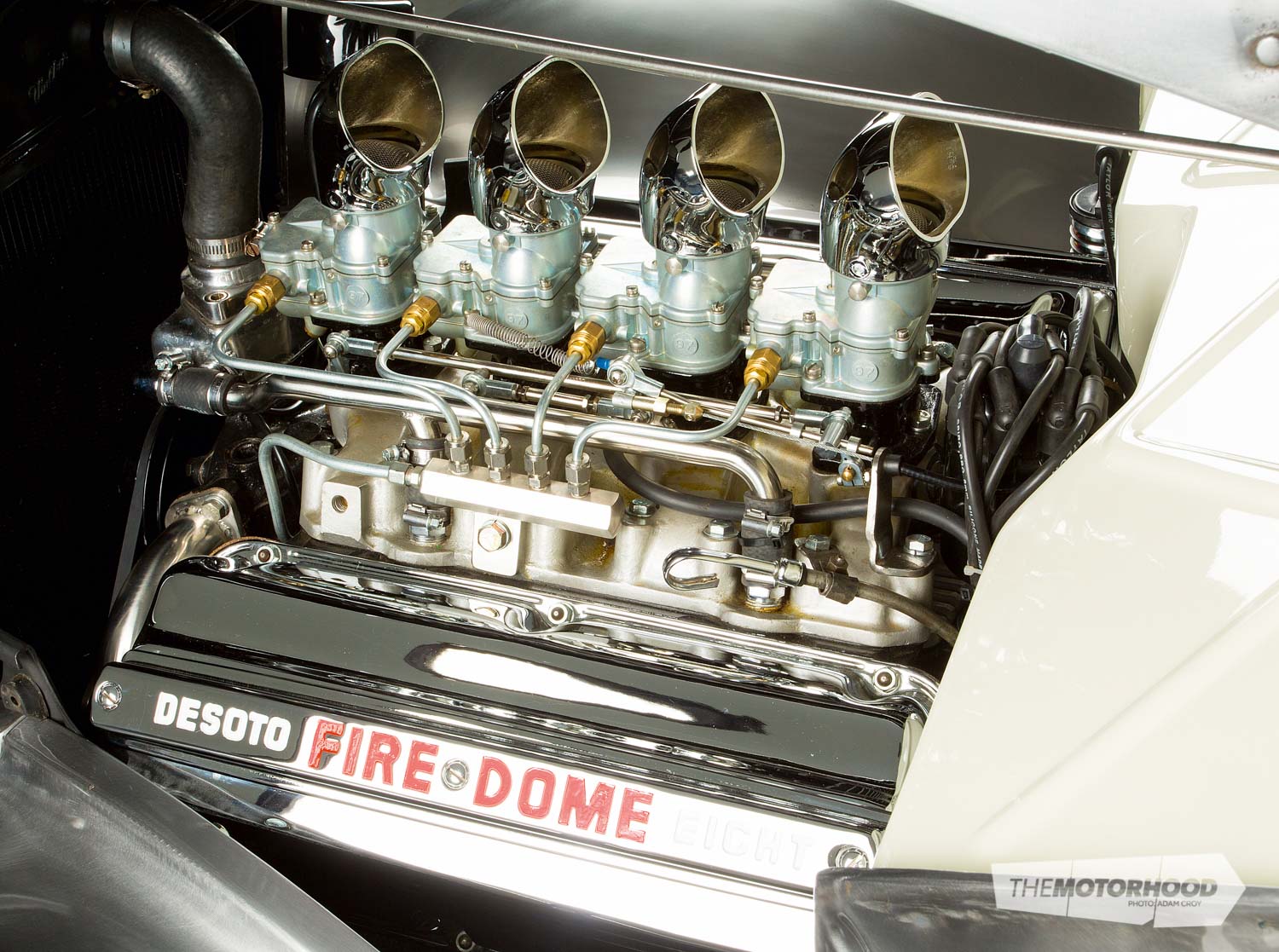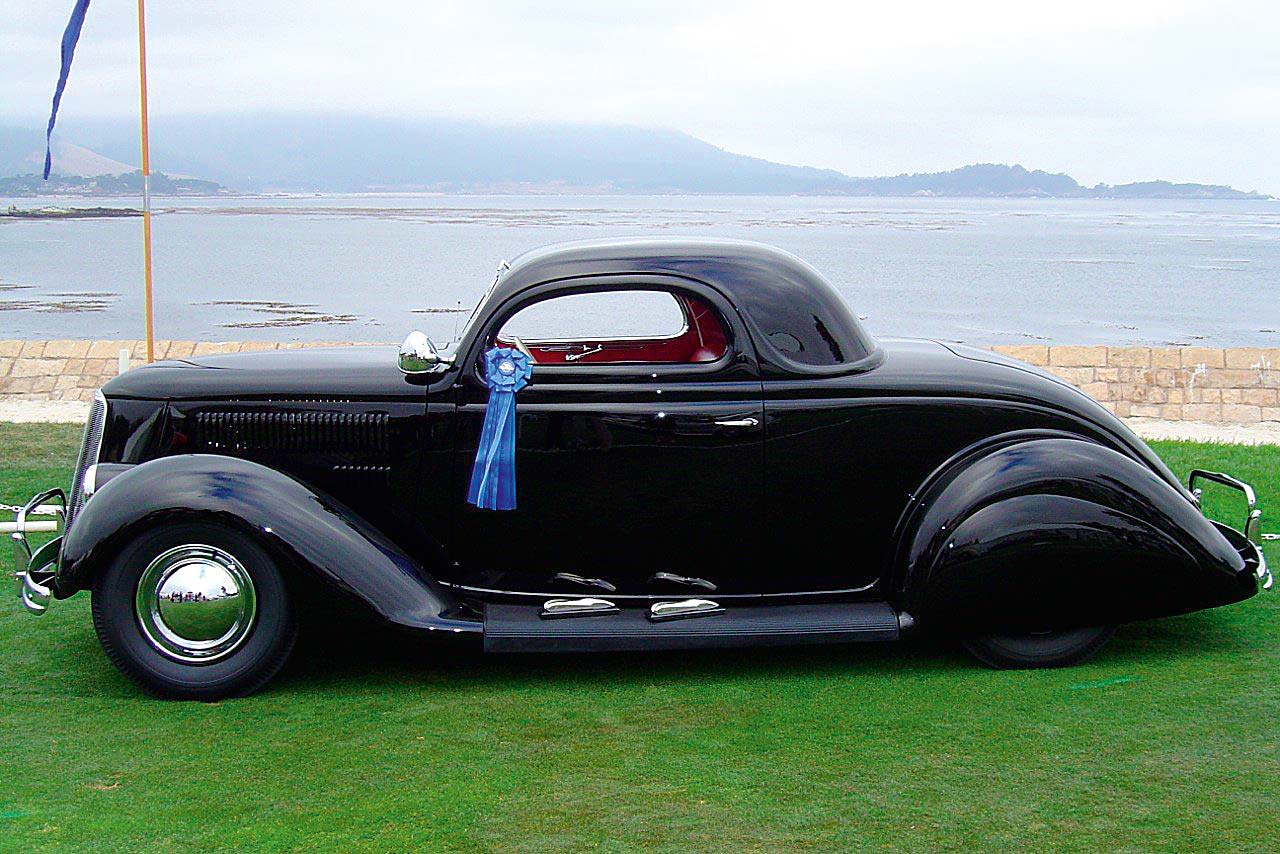The 1936 Ford coupe you see here is a car that has hit a number of home runs. Some cars have the look, the style, the stance, or the overall wow factor, but very few have all those factors rolled into one. This is one of those cars. Mind you, it’s what we had come to expect from the late Steve Foster, the artistic long-time rodder who had the vision to build such a fine custom Ford coupe. Some have referred to this car as his masterpiece, and we couldn’t agree more. This was to be Steve’s last hot rod and, as with his previous ’40 Ford pickup and ’33 Ford coupe, he nailed it.

Steve passed away in October 2013; he was just 58 years old. Steve spent the short time he had wisely, achieving his goals with the love and assistance of his wonderful wife, Tania, his family, his friends, and his fellow members of the Mid West Street Rods club, of which he became the first life member. It’s well known within rodding circles that Steve was definitely one of the good guys. He was highly regarded for his artistic talent and his appreciation for traditional hot rods. He was one of the handful of people in New Zealand about whom, when their name pops up in conversation, you know that their next project will be a winner. He had a lifetime of amazing cars and motorcycles, from the two cars already mentioned, to a ’51 Ford custom, early Camaros, Tri-Five Chevs, Mustangs, vintage Harleys, and many hot rods.
Four-and-a-half years prior to his passing, Steve was diagnosed with bowel cancer. It was removed only for him to learn of more complications with his liver. Certainly not one to sit back, Steve stepped up and sought alternative natural-health medicine and leading-edge surgery to maximize his life expectancy. The man was certainly on a mission to tick off the projects left in his garage, and his family, friends, and fellow club members also stepped in to see Steve achieve his goals. Close family friend Clark Raven met Steve each day to discuss where Steve was at with everything and, as any good friend would, he would listen, advise, project-manage, and join the dots for Steve and Tania through what became a tough time for all. Steve wanted to ensure that Tania didn’t have to worry about, or struggle with, a garage of unfinished projects. Steve’s brothers, Barry and Graham, made a significant contribution to achieving Steve’s goals. It was a real team effort from all involved.

This story is very inspirational, and many things can be learnt from not only the car and its styling but also the way Steve approached things and achieved his goals. Makes you think about things, doesn’t it?
The car was certified and complied on Wednesday, October 9, 2013 and photographed in our studio a few days later. Steve went for what would be his final ride in the car on Sunday, October 13. The Mid West Street Rodders’ monthly breakfast took place one week later, and Clark drove the ’36 for all to enjoy. Then, on the way home, a group of cars swung by the hospice and revved their engines outside Steve’s room to pay their respects to him. Steve’s nurse came out to see what all the noise was. Having already learnt all about Steve’s cars, she asked Clark to show her the various cars with Steve’s pinstriping on them. As far as final days went, it was just one of many special days for this fine car and the man behind the vision. Five days later, family, friends, and fellow rodders celebrated Steve’s life and, if it is appropriate to say that it was humorous, casual, and perfect, then the day was all of those.

To understand where Steve was coming from when he commenced the build of this car, we need a small glimpse back into the history of American hot rods and custom cars. The Jack Calori coupe (pictured below) takes us back to Long Beach, California, in the late ’40s. In 1947, Calori was searching for a tow car for his famous Clay Smith–prepared 1929 Ford Model A racer when he discovered a 1936 Ford three-window coupe for sale by its original owner. It was not long before Calori’s friend, local body man Herb Reneau, convinced Calori that the Ford needed the custom treatment, and one of history’s most stunning custom 1936 Fords was born. Reneau installed a dropped front axle and Z’d the frame at the rear to lower the car; he chopped the top three inches, and massaged the front end to accept a 1939 LaSalle front grille and 1941 Chevrolet headlights. The men then added fender skirts, 1941 Hudson tail lights, and 1941 Ford bumpers with Lincoln overriders, and finished the car off with lustrous black paint.

The Jack Calori coupe
Just prior to the car’s completion, Calori installed the race-prepped 1946 Mercury flathead from his Model A, giving it the power to run 114.5 miles per hour at a 1948 Russetta Timing Association meet. Calori and his coupe made history the following year, appearing on the front cover of the November 1949 issue of [American] Hot Rod Magazine. In 2002, Jorge Zaragoza commissioned hot-rodding legend Roy Brizio to restore it in time to win the first-ever Early Custom Cars 1935–1948 class and the Dean Bachelor Award at the 2005 Pebble Beach Concours d’Elegance, where Brizio and Calori himself accepted the prizes. The car has been displayed at the Petersen Automotive Museum as a living piece of hot-rod history.
Along with knowledge about the Jack Calori coupe and a few other similar recent builds, Steve was armed with magazines, internet research, and photos to embark on what is perhaps New Zealand’s first late-’40s–styled custom coupe. The car was sourced via Squeak Bell in the US. Steve decided that it was certainly worth talking to Paul Duff at Bodymods in Hamilton, and it was to be a choice for which we can all be grateful, as the results certainly speak for themselves. Initially, Steve just wanted to visit Paul and the team to suss them out. Clark suggested towing the car down and things stemmed from there when Steve asked Paul, “Do you have space to take the car now and work out an estimate?”

Bodymods’ panel work and perfection are a real study of what Paul says is approximately 30 modifications. “The work ranged from two hours to fill a fuel-filler hole to around 100 hours to hand-build the nose to house the LaSalle grille, including reshaping the hood tops to suit,” says Paul. “Plus over 60 individual patch panels — two of which were aftermarket items, with the rest being made in-house; this included the full rear panel that spans from the trunk lid to the rear bumper. The biggest challenge was resurrecting two very tired rear fenders, as Steve was unable to source better ones; they were thin, damaged, poorly repaired, rusty, and different left to right. Steve did give us some artistic licence with things such as the rear wheel spats, dash, firewall, gearbox tunnel, and LaSalle grille — which, although done before, I doubt had ever been done the same way twice; we had to set the height and rake just right and hope the boss [Steve] was happy with the end result.”
Paul says it was a privilege to be part of a build that was backed by an owner with such good knowledge, and who was combining a lifetime of ideas into one dream car. “It was that alone which gave us the confidence to just do our job well, knowing when it left the shop it would be finished to a very cool and admirable standard. All four of us were involved to varying degrees, working to the strength of each person.”
To conclude, we agree totally with Paul’s final comment, “Time was the enemy on this one. Couple this with Steve’s relentless passion to achieve his vision. How the hell did these guys get this car finished? It’s the power of genuine friendship!”
Steve always said that a hot rod should be hammered and filed and driven hard. So, with that in mind and time becoming somewhat limited, it was decided to clear coat the car to showcase the beautiful craftsmanship. The initial vision was a gloss-black paint job à la Jack Calori. However, as Steve realized how little time was left, he started to say he would just matte black the car and enjoy it. Clark suggested that a matte-black paint job would not do the car or its creators any justice, and that’s when Mark McAlpine of Alpine Panelbeaters stepped up. The car looks bare metal but is in fact painted in an epoxy clear coat from PPG, which seals and protects the steel from the elements but can also be sanded back with minimal effort to apply a topcoat colour at a later stage.

Back to the driven-hard part, it was Dave and Craig McDougall of D&V Autos who carried out the chassis work in a traditional manner. It features a So-Cal forged dropped I-beam axle on a ’36 Ford spring and wishbone, and a Ford nine-inch diff on triangulated four-bars with QA1 coilovers at the rear end. Note: there are no air bags on this car; that’s Steve’s traditional bent coming out — much like the use of a 1955 291ci DeSoto Hemi engine topped with four Stromberg 97 carburettors on an Offenhauser intake. The engine was freshened up by John and Scott Sampson at Glendene Engine Reconditioners, and a testament to their work is that the engine has run like a Swiss watch since first turn of the key. A modern concession is the BorgWarner T5 gearbox for improved drivability. Fellow Mid West Street Rods member Trev Saran handled the wiring as family, friends, and fellow club members pitched in to get the car running.
Master fabricator Dave Graham put his hand to many cool aspects of the car, including the bullets on the hubcaps and the licence-plate guard. In a kind gesture, Dave’s employer, James at Bumac Engineering, told Dave to do whatever it took (during work time) to get the jobs completed. Mark Stokes of MS Vehicle Certifications must also be acknowledged. He went above and beyond the call of duty to ensure the certification would be handled efficiently as time marched on. From Steve’s initial vision of his final masterpiece, right through to all those who lent a hand in achieving the end result, this hot rod is well and truly a work of art. The ‘GR8VBE’ licence plates were a gift from Tania to Steve, and are more than fitting for the car, as you sense a great vibe when you view it — not to mention Steve’s appreciation of musical vibes and the pulse of a stick-shift hot rod. From the cars to the art to the music, Steve Foster represented what some of us younger guys saw as the ultimate hot rodder. RIP, Steve!




